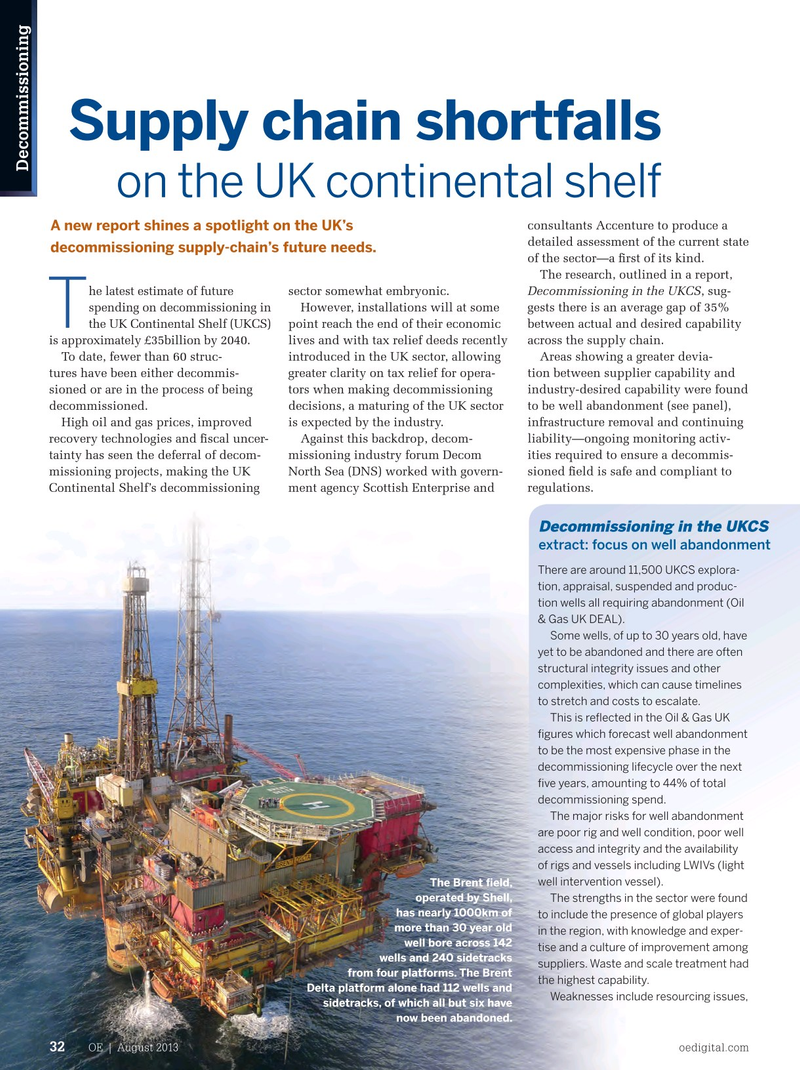
Page 30: of Offshore Engineer Magazine (Aug/Sep 2013)
Read this page in Pdf, Flash or Html5 edition of Aug/Sep 2013 Offshore Engineer Magazine
Supply chain shortfalls
Decommissioning on the UK continental shelf consultants Accenture to produce a
A new report shines a spotlight on the UK’s detailed assessment of the current state decommissioning supply-chain’s future needs.
of the sector—a frst of its kind.
The research, outlined in a report, sector somewhat embryonic. Decommissioning in the UKCS, sug- he latest estimate of future
However, installations will at some gests there is an average gap of 35% spending on decommissioning in point reach the end of their economic between actual and desired capability the UK Continental Shelf (UKCS)
T lives and with tax relief deeds recently across the supply chain.
is approximately £35billion by 2040.
To date, fewer than 60 struc- introduced in the UK sector, allowing Areas showing a greater devia- tures have been either decommis- greater clarity on tax relief for opera- tion between supplier capability and sioned or are in the process of being tors when making decommissioning industry-desired capability were found decommissioned. decisions, a maturing of the UK sector to be well abandonment (see panel),
High oil and gas prices, improved is expected by the industry. infrastructure removal and continuing recovery technologies and fscal uncer- Against this backdrop, decom- liability—ongoing monitoring activ- tainty has seen the deferral of decom- missioning industry forum Decom ities required to ensure a decommis- missioning projects, making the UK North Sea (DNS) worked with govern- sioned feld is safe and compliant to
Continental Shelf’s decommissioning ment agency Scottish Enterprise and regulations.
Decommissioning in the UKCS extract: focus on well abandonment
There are around 11,500 UKCS explora- tion, appraisal, suspended and produc- tion wells all requiring abandonment (Oil & Gas UK DEAL).
Some wells, of up to 30 years old, have yet to be abandoned and there are often structural integrity issues and other complexities, which can cause timelines to stretch and costs to escalate.
This is refected in the Oil & Gas UK fgures which forecast well abandonment to be the most expensive phase in the decommissioning lifecycle over the next fve years, amounting to 44% of total decommissioning spend.
The major risks for well abandonment are poor rig and well condition, poor well access and integrity and the availability of rigs and vessels including LWIVs (light well intervention vessel).
The Brent feld, operated by Shell,
The strengths in the sector were found has nearly 1000km of to include the presence of global players more than 30 year old in the region, with knowledge and exper- well bore across 142 tise and a culture of improvement among wells and 240 sidetracks suppliers. Waste and scale treatment had from four platforms. The Brent the highest capability.
Delta platform alone had 112 wells and
Weaknesses include resourcing issues, sidetracks, of which all but six have now been abandoned.
OE | August 2013 oedigital.com 32 032_OE0813_Decom-UK.indd 32 7/22/13 1:29 PM

 29
29

 31
31